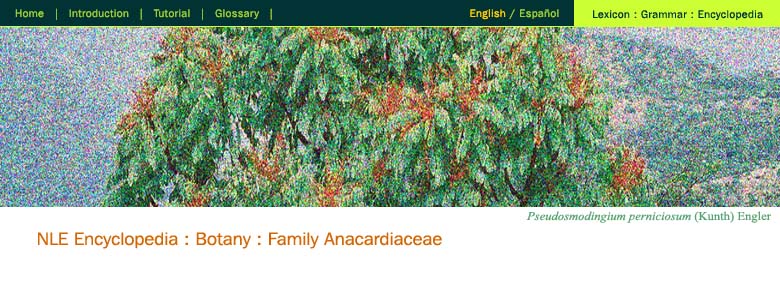

|
Anacardiaceae : The Cashew or Sumac Family Anacardiaceae are generally trees, shrubs, or woody vines, with some lianas. Leaves are pinnate-compound, alternate, and sometimes simple; they are entire (without toothing) to serrate (having sharp teeth) and lack stipules. Flowers can be perfect, though occasionally imperfect, hypogynous (beneath the ovary) to epigynous with 5 fused sepals and 5 free petals. Flowers are actinomorphic (radially symmetrical with more than one plane of symmetry) with overlapping white, green, or yellow petals. A fleshy disc, which excretes nectar that along with the small flowers and large inflorescence attracts pollinating insects, holds 5-10 stamens that separate both the superior ovary and 1-3 widely separated styles from the stamen. The ovary comprises 3 united carpels with one fertile pendulous ovary. The embryo is curved with a thin to no endosperm. The plants of the Anacardiaceae family are both dioecious (having unisexual flowers with male and female flowers on different plants) or polygamodioecious (having bisexual flowers along with both only male and only female flowers on the same plant). Fruit is a drupe with resinous mesocarp, nut, or samara (one-seeded, indehiscent winged fruit). Many Anacardiaceae species produce a resinous material containing urushiols (alkenyl phenols), often in the form of milky sap that is irritating to the skin. The sap is concentrated in interior canals that can be found throughout the plant, in its bark, or at a single source area such as a leaf. The Anacardiaceae family comprises approximately 60 genera and 600 species most of which are native throughout tropical and subtropical zones of the Americas, Malaysia, and Africa, although some are autochthonous to the Mediterranean regions. Many species are economically important because of their tannins and resins (often used for varnishes), for their edible nuts and fruits, or for their wood, which may be frequently used as timber. Common cultivated genera include Anacardium (14 species), Astronium, Cotinus, Harpephyllum, Lithrea, Mangifera, Pistacia, Rhus (200 to 250 species), Schinus, and Spondias. Eight species of the genus Anacardium provide edible nuts, most significantly the Anacardium occidentale, or cashew, which is an important cultivated tree from the Americas. Its nuts are edible when roasted, although the juice from the raw outer shell can cause skin burns. Mangifera indica, mango, is another well-known and diversified Anacardiaceae species. For example, it is commonly planted in Hawaii, where more than 40 varieties are found. Besides its fruit, its bark is also commercialized for making tanning leather and dyes. Although the resin of the mango plant provokes an allergic reaction in some people, there are other Anacardiaceae more noted for the adverse reactions they may provoke, particularly as skin irritants. Toxicodendron diversilobum, poison oak, is a common North American species that causes an allergic reaction in some people. Other toxic plants of this family are Toxicodendron radicans (also known as Rhus toxicodendron), poison ivy, which contains skin irritants. Native to North America, it was actually introduced into Europe as an ornamental in the mid-1600s. Other irritating plants of the Anacardiaceae family are Toxicodendron diversilobum (Rhus diversiloba), the Western poison oak, and Toxicodendron vernix (Rhus venenata), poison sumac. Popular cultivated species include Schinus molle, the pepper tree, and Pistacia vera, the pistachio nut. Various Anacardiaceae are also cultivated for ornamental purposes, such as the R. cotinus, or Venetian sumac, a common garden shrub native to southern Europe that is favored because of its resistance to frost. Some species of Rhus provide the basis for beverages. One such plant is the R. trilobata, or the three-leaf sumac, which is known by indigenous peoples as lemonade bush. This plant was cultivated and its berries were mixed with water for a beverage. Various parts of several Anacardiaceae are also used medicinally. For example, Rhus glabra (Smooth sumac) has been employed as astringent and diuretic, among other uses. A diluted fluid extract serves a gargle for angina and is useful in halting diarrhea. Native Americans used this same plant in the treatment of bacterial diseases, such as syphilis, gonorrhea, dysentery, and gangrene. To date six species of Anacardiaceae have been collected in the Oapan, San Juan Tetelcingo, and Ameyaltepec area, belonging to the genera Amphipterygium (1 species), Comocladia (1 species), Cyrtocarpa (1 species), Pseudosmodingium (2 species), and Spondias (1 species). Although no variants of Pseudosmodingium perniciosum have been documented in the literature, many Nahuatl consultants recognize two types of kuwxio:pa:pa:lo:tl (Am), one red (chi:chi:ltik) and the other white (istá:k). The following members of this family have been documented in sources consulted on Guerrero flora: Actinocheita filicina, Actinocheita potentillaefolia, Comocladia engleriana, Comocladia mollissima, Cyrtocarpa procera, Pistacia mexicana, Pseudosmodingium andrieuxii, Pseudosmodingium multiflorum, Pseudosmodingium sp., Pseudosmodingium perniciosum, Rhus chondroloma, Rhus nelsonii, Rhus oaxacana, Rhus terebinthifolia, and Spondias purpurea. |
List of Anacardiaceae species collected, with most common Nahuatl names
* see Sapindaceae family page